Explore the accuracy, design, and dynamics of wind vanes, from traditional weather instruments to modern digital advancements and artistry.

Understanding Wind Vanes: Accuracy, Design, and Dynamics
Wind vanes, also known as weather vanes, are devices used for indicating the direction of the wind. They are one of the oldest weather instruments and have evolved significantly in terms of design and accuracy. Understanding the principles behind wind vanes is crucial for meteorologists, sailors, and anyone interested in weather patterns.
Accuracy of Wind Vanes
The accuracy of a wind vane depends on several factors, including its design, location, and the materials used in its construction. To achieve high accuracy, wind vanes must be placed in an open area, away from obstacles that can cause turbulence or deflect wind. The balance of the vane is also critical; it must be perfectly centered on its axis to respond accurately to wind direction changes.
Design Elements of Wind Vanes
Wind vane designs have varied throughout history, from simple arrows to elaborate artistic sculptures. The design typically consists of a rotating element, known as the vane, mounted on a vertical rod. The vane usually has a broad end, which catches the wind, and a pointed end that indicates the direction. Materials used in modern wind vanes range from lightweight metals like aluminum to durable plastics, each offering different benefits in terms of responsiveness and longevity.
Dynamics of Wind Vane Movement
The movement of a wind vane is governed by aerodynamics. The broader end of the vane is designed to have more surface area and, consequently, experiences more wind pressure than the pointed end. This difference in pressure causes the vane to align itself with the wind direction. The rotational movement is usually smooth, thanks to bearings in the mounting mechanism, allowing the vane to respond quickly to changes in wind direction.
Additionally, the height at which a wind vane is mounted can influence its performance. Higher elevations typically provide clearer, more accurate readings by avoiding ground-level obstructions and turbulence. However, this must be balanced against the increased exposure to the elements and potential maintenance challenges.
Modern wind vanes often incorporate electronic sensors to enhance their accuracy. These sensors can detect even slight changes in wind direction and speed, transmitting this data to digital displays or integrating it into weather monitoring systems. The combination of traditional design principles and advanced technology makes today’s wind vanes both functional and precise tools for weather observation.
Technological Advancements in Wind Vane Design
With the advent of modern technology, wind vanes have undergone significant advancements. Integration of digital sensors has not only increased the accuracy of wind direction measurements but also allowed for real-time data transmission to weather forecasting systems. This integration has become crucial in activities like aviation, maritime navigation, and even in renewable energy sectors, particularly in wind farms.
Material and Durability Considerations
The choice of material for a wind vane is pivotal in its design. Durability is a key factor, especially in harsh weather conditions. Metals such as copper and stainless steel are popular for their resistance to corrosion and rust, while lightweight materials like aluminum offer minimal inertia, allowing for quick response to wind changes. The longevity and maintenance requirements of a wind vane depend greatly on these material choices.
Artistic and Cultural Significance
Wind vanes also hold an artistic and cultural value. Historically, they have been used not just as weather instruments but as architectural ornaments, reflecting local culture and craftsmanship. This decorative aspect continues today, with custom designs ranging from simple geometric shapes to intricate representations of animals, ships, or mythical figures.
Environmental Factors Affecting Performance
Environmental factors play a significant role in the performance of wind vanes. Urban settings, with their buildings and structures, can create complex wind patterns, leading to less accurate readings. Conversely, in open, rural areas, wind vanes can provide highly reliable data. It’s crucial for users to consider their environment when installing and interpreting data from a wind vane.
Conclusion
Wind vanes, with their rich history and evolving technology, remain an essential tool in weather observation and forecasting. Their design, balancing artistry with functionality, has been refined over centuries to accurately capture wind direction. Today’s wind vanes blend traditional mechanics with advanced technology, offering precision and reliability. Whether used for practical purposes in meteorology and navigation, or as an artistic expression, wind vanes continue to be a fascinating and vital element in our interaction with the natural world.
